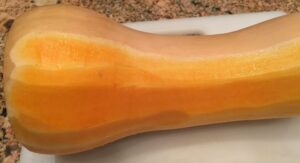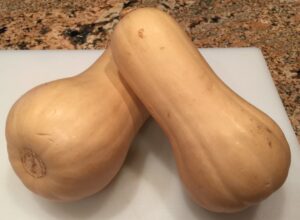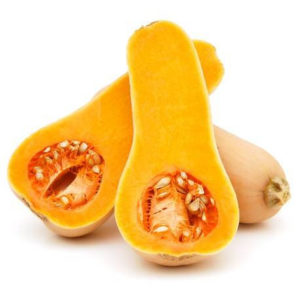OK, we’re not going to get into a big botanical debate. It’s got seeds inside of it so technically your butternut squash is a fruit. You’ll have to deal with that in your own way.

While it may not technically be a vegetable, the ole “quacks like a duck” argument allows us to treat it like a veggie and that’s what we’re going to do. (BTW-those seeds are edible, raw or roasted) Butternut squash is of the winter squash variety- the snobbish, uptown relative of its country cousins, summer squash. Other common winter squash members are acorn squash and spaghetti squash, but the list goes on and on and would make you sound like Bubba Blue in Forest Gump if you recited it. The winter variety has harder rind-like skin that needs to be removed while the summer variety’s skin is softer and can be eaten without being peeled. Butternut squash’s peak season is summer through autumn, although it’s not uncommon to see them in the grocery stores year-round.
You’ve all seen the pile of tan, sort of elongated pear shaped, rock hard specimens in the grocery produce department. Therein lays the challenge. No matter when you see them, they look the same, how do you know when they are ripe? It’s not like a banana who wears its emotions and its freshness on its sleeve-if its green, it ain’t ready, if its full of black spots it’s probably overripe, but a beautiful deep yellow skin alerts you that’s its feeling good and ready to party. It’s also not like an avocado that plays hard to get. Check it out today and its hard as a rock, come back tomorrow and it may have soften a little and gets your attention, by the next day, it's softness in your hands tells you you’ve finally won it over. Nope, a butternut squash will look the same today, tomorrow, next week and next month. To the observant veggie hunter, there are some subtle clues, however, to look for and help you know when its ready to go. Basically that’s color, feel and the tap-test.
Color, Feel and Tap-its what you need to know

First, the color should be beige, the darker the better. An unripe butternut, like a banana will be green and loose its green color as it ripens. If you look close there are some lines like ribs that run from stem to stern. These lines will be the last to give up their green color. There should be no other green spots or cuts and blemishes. The skin should have sort of a dull, matte like finish and not be shiny. The butternut when mature can be between 8 and 12 inches long and with about a 5-inch diameter on the fat end. It should be heavier than it appears, so the feel test is just that. Pick it up and feel the weight. Try a few of the others in the pile that look a little different. It’s a good bet that the heavier one is the winner. Now the third test-the tap test. This is the one that will make you look like you know what you’re doing. Pick one up and give it a little rap with your knuckles. You’re looking for a hollow thud. Test a few of them, the other shoppers will look at you in awed regard-you obviously know a lot about your veggies or fruits or whatever they are. Why else would you be thumping them?
But are they good for you??

So, you have a ripe butternut squash. It will be delicious in your soup or roasted or pureed, but it will also be good for you? You bet! Butternut squash are highly regarded for their nutritional benefits. They are fat free, cholesterol free, sodium free, low in calories and a good source of fiber, potassium, and magnesium and a good source of Vitamin A, C, E and K. There's also the B vitamins, including thiamine, riboflavin, niacin, folate, pantothenic acid and pyridoxine.
Butternuts are loaded with the antioxidant carotenoids and a good source of beta-carotene and of the rarer antioxidants beta cryptoxanthin. Research shows all this protects the body’s cells from free-radical damage that can lead to cancer, skin aging and reduce the risk of developing arthritis and lung cancer-it also has antioxidants that are good for your vision. These guys are a less starchy alternative to sweet potatoes and fit right in to your paleo diet. Wow! Gimme some!
For you real Butternut Squash nerds out there, scientifically we are talking about Cucurbita moschata. The variety that most of us in the United States are used to is the Waltham Butternut Squash that was developed in Waltham, Massachusetts at the Waltham Experiment Station.
If you haven’t had enough and want some more, try these sites:
https://www.fruitsandveggiesmorematters.org/butternut-squash

Comments
No Comments